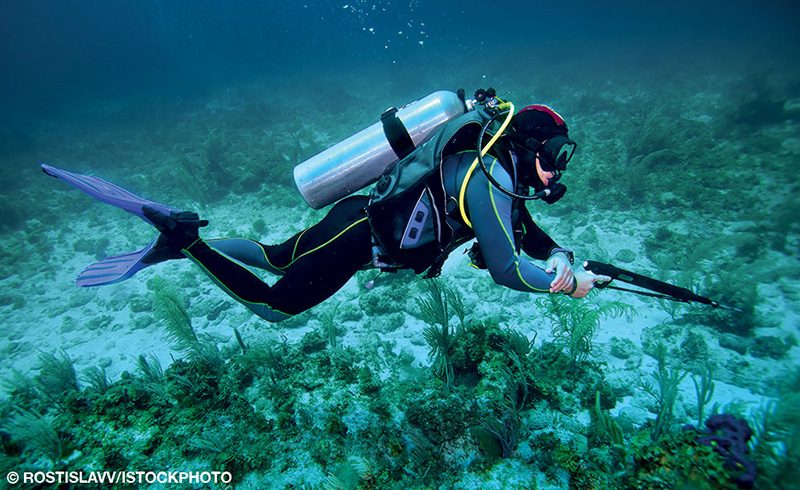The diver is a 41-year-old male recreational diver with a lifetime dive history spanning 20 years and with approximately 30 dives within the past two years. He considers himself healthy overall with a “clean slate” in both his medical and dive history.
The Dives
The diver had a series of three open-water dives on a single day for spearfishing 30 miles off the Florida coast. Each dive was on 33 percent enriched air nitrox (EAN) and followed the same multilevel computer profile with a maximum depth of 124 feet of seawater (fsw) for a total bottom time of 13 minutes on each dive. A surface interval of 90 minutes separated each dive.
Complications
The first two dives were uneventful and uncomplicated, but on the third dive the diver experienced a rapid out-of-air emergency ascent directly to the surface from depth. Upon surfacing, he realized that the entire left side of his body was acutely numb with intense tingling. “It was as if someone had covered the left side of my body with a nail blanket,” he explained. He was not aware of any other symptoms or signs.
Realizing that his symptoms were likely a result of decompression illness (DCI), he donned a fresh tank of air and reentered the water to a depth of 49 fsw, and then began a gradual ascent to a decompression stop at 15 fsw for the next 30 minutes. This process exhausted the remainder of two tanks of air. He used a third tank filled with 34 percent EAN to complete approximately an hour of total decompression time. He emerged with mild symptoms of persistent numbness and tingling on his left side.
He returned home, and about two hours after his last dive he contacted the DAN emergency hotline seeking guidance for what he feared was DCI. DAN medics immediately referred him to the nearest emergency department that was familiar with treating dive-related illnesses and injuries and asked the diver to tell the evaluating doctor to contact DAN for consultation if needed.

Treatment
Despite the diver’s existing symptoms, the hospital’s triage process failed to acknowledge possible DCI along with the need for immediate evaluation and first aid oxygen, leaving him sitting in the waiting room for five hours. During this time, generalized fatigue and transient left elbow pain began to accompany the left-sided numbness. When the diver was finally evaluated, the emergency department physician ruled out other possible causes and realized the need for hyperbaric chamber treatment. The diver was placed on 100 percent oxygen and transferred to the nearest operational hyperbaric facility approximately two hours away. The numbness began resolving with the oxygen administration.
After arriving at the chamber and following a chest X-ray to rule out pulmonary barotrauma, the diver began an extended U.S. Navy Treatment Table 6 now 16 hours after his last dive. The treatment completely resolved all his symptoms. One week later the diver noted the return of mild intermittent tingling throughout his left forearm, hand and both feet and was told to take over-the-counter nonsteroidal anti-inflammatory drugs (NSAIDs) as treatment. The residual symptoms waxed and waned during the next four to five days and gradually diminished to his baseline normal status.
Discussion
The term decompression illness evolved in part because of difficulty establishing a differential diagnosis between arterial gas embolism (AGE) and spinal cord decompression sickness (DCS). Although the rapid ascent in this case along with the immediate symptoms upon surfacing and the unilateral presentation strongly suggested AGE, spinal cord DCS could not be ruled out. Both conditions could have been present. It is possible that bubbles were arterialized and reached the spinal cord, but the brain is often the most affected. It is equally likely, if not more so, that the rapid ascent did not allow adequate decompression that directly impacted the spinal cord to produce the sudden appearance of symptoms. Either way the diver was in trouble.
Is in-water recompression a good idea? Many dive authorities recommend in-water recompression only if you are in a remote location far from a recompression chamber and no other options or appropriately trained staff and equipment are available. The increased pressure while breathing 100 percent oxygen determines the effectiveness of recompression therapy. The U.S. Navy Treatment Tables 5 and 6 were developed in the 1950s and greatly increased the amount of oxygen over previous treatments. Other treatment procedures, including in-water recompression, have also evolved with the introduction of higher partial pressures of oxygen.
Current experience suggests that without breathing 100 percent oxygen at partial pressures above 2 atmospheres absolute (ATA), recompression will be less effective and relapse rates will be high. The U.S. Navy discourages any in‑water recompression unless a hyperbaric chamber cannot be reached within 12 hours; if in‑water recompression must be used, the diver should also breathe 100 percent oxygen.
The preferred first aid for divers with DCI symptoms is surface-level oxygen, which maximizes the partial pressure gradient to enhance the elimination of nitrogen (off-gassing), decreasing the size and number of bubbles and reducing the symptoms. The most efficient way to administer 100 percent oxygen is to use the demand valve. All divers with suspected DCI should receive first aid surface-level oxygen during transportation to or while waiting for treatment in a recompression chamber.
© Alert Diver — Q4 2019